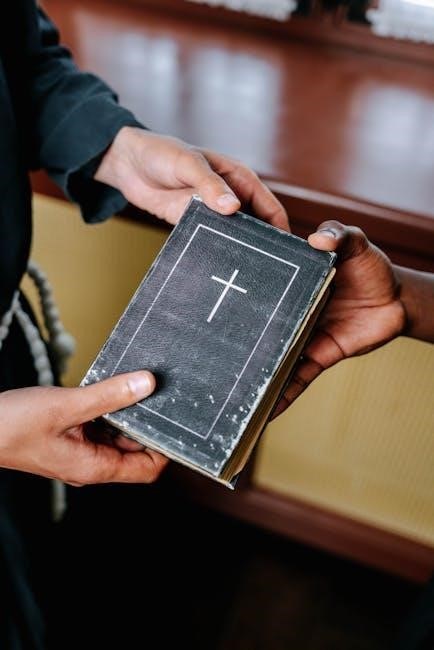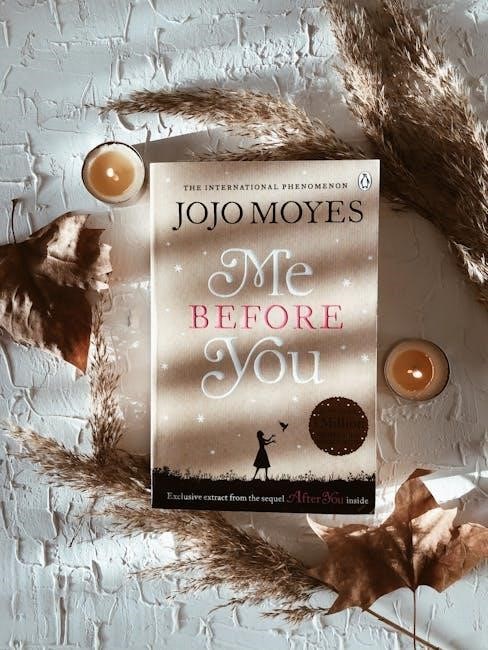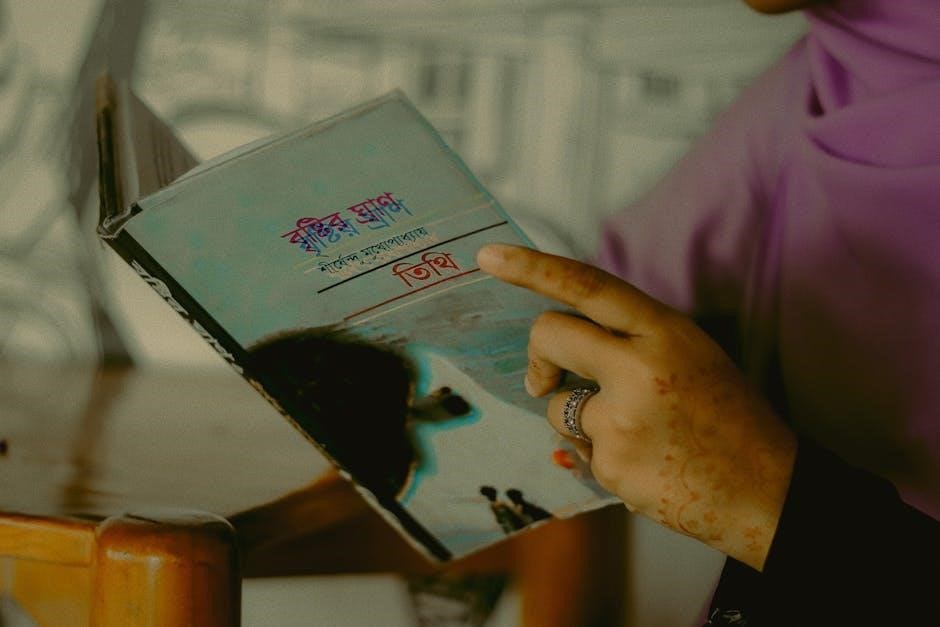The Hate U Give is a powerful young adult novel by Angie Thomas, exploring themes of racism, police brutality, and the struggle for justice. The book’s PDF version remains widely popular, offering readers convenient access to Starr Carter’s compelling story and its impactful commentary on societal issues;
Overview of the Novel
The Hate U Give by Angie Thomas is a gripping young adult novel that follows 16-year-old Starr Carter, a Black girl navigating two worlds: the impoverished neighborhood of Garden Heights and the affluent, predominantly white private school she attends. When Starr witnesses the fatal shooting of her unarmed friend Khalil by a white police officer, her life is forever changed. The novel explores themes of racial injustice, identity, and activism, offering a raw and unflinching look at systemic inequality. Its impactful storytelling has resonated widely, making it a critical and commercial success.
Relevance of the Book in Modern Society
The Hate U Give remains a vital commentary on systemic racism and police violence, issues central to the Black Lives Matter movement. Its unflinching portrayal of injustice resonates deeply in today’s society, sparking essential conversations about equality and accountability. The novel’s exploration of identity and activism continues to inspire readers, making it a cornerstone of contemporary young adult literature. Its widespread popularity and inclusion in educational curricula highlight its enduring relevance in addressing and educating about racial disparities and the fight for justice.
Themes Explored in “The Hate U Give”
The Hate U Give delves into racism, police brutality, and the fight for justice, while exploring identity, activism, and systemic inequality, resonating deeply with contemporary societal issues.
Racism and Police Brutality
The Hate U Give vividly portrays the harsh realities of racism and police brutality through Starr’s traumatic experience of witnessing Khalil’s murder by a white officer. The novel underscores the deep-rooted systemic racism that perpetuates fear and mistrust within communities of color. The title, inspired by Tupac’s “THUG LIFE” acronym, highlights how societal hatred towards marginalized groups fuels cycles of violence and oppression. Thomas’s portrayal of these issues sparks critical conversations about justice, accountability, and the urgent need for systemic change, resonating with the Black Lives Matter movement and contemporary struggles for equality.
The Struggle for Justice and Equality
The Hate U Give delves deeply into the struggle for justice and equality, particularly in the wake of Khalil’s murder. Starr’s journey from silence to activism highlights the systemic barriers faced by marginalized communities in their pursuit of fairness. The novel sheds light on the Black Lives Matter movement, emphasizing the importance of collective action and the need to challenge oppressive systems. Through Starr’s voice, Thomas underscores the resilience of communities fighting for equality and the transformative power of demanding accountability in the face of injustice.
Identity and Belonging
The Hate U Give explores Starr Carter’s dual identity as she navigates two worlds: the impoverished black neighborhood of Garden Heights and the predominantly white private school she attends. Starr struggles to reconcile her authentic self with the personas she adopts in each environment. The novel delves into her internal conflict, highlighting the tension between cultural loyalty and social expectations. Through Starr’s journey, Thomas examines the complexities of belonging and the challenges of self-definition in a society marked by racial and class divides, ultimately emphasizing the importance of embracing one’s true identity.
The Power of Activism and Voice
The Hate U Give underscores the transformative power of activism and voice in challenging systemic injustice. Starr Carter’s journey from silence to advocacy highlights the importance of speaking out against racism and oppression. Through her experiences, the novel illustrates how individual voices can spark collective change and amplify marginalized communities. The book’s emphasis on activism resonates deeply, encouraging readers to find their own voice and use it to demand justice and equality in a society fraught with inequality and systemic racism.
Plot Summary of “The Hate U Give”
The Hate U Give follows Starr Carter, a teenager navigating two worlds, as she witnesses the fatal shooting of her friend Khalil by a police officer, sparking her activism.
Starr Carter’s Dual Worlds
Starr Carter navigates two vastly different worlds: the impoverished, predominantly Black neighborhood of Garden Heights, where she lives, and the affluent, mostly white private school she attends. Her dual existence requires constant adaptation, as she balances the stark contrasts between her home life and school life. In Garden Heights, Starr is deeply rooted in her community and family, while at Williamson, she often feels the need to mask her true self to fit in. This duality shapes her identity and underscores the challenges of belonging in two disparate environments, adding depth to her journey of self-discovery and activism.
The Inciting Incident: Khalil’s Death
The death of Khalil, Starr’s childhood friend, at the hands of a white police officer, is the inciting incident that drives the plot of The Hate U Give. This traumatic event forces Starr to confront the harsh realities of systemic racism and police brutality. Khalil’s death becomes a catalyst for Starr’s activism, as she decides to use her voice to demand justice and challenge the injustices faced by her community. The incident sparks widespread outrage and solidarity, highlighting the broader societal issues the novel addresses.
Starr’s Journey Toward Activism
Starr’s journey toward activism begins with her traumatic witness to Khalil’s death and grows as she grapples with fear, guilt, and societal expectations. Initially hesitant to speak out, Starr finds her voice through support from her family and community, realizing the power of activism. Her decision to testify in the investigation and speak at a protest marks her transformation from a silent bystander to a courageous advocate. This journey highlights her growth in identity and her role in challenging systemic injustice, inspiring others to join the fight for equality and accountability.
Climax and Resolution
The climax of The Hate U Give unfolds as Starr faces the aftermath of Khalil’s death, culminating in a tense jury verdict that sparks widespread riots in Garden Heights. Starr’s emotional turmoil peaks as she confronts the systemic injustice and personal loss. The resolution sees Starr finding her voice, embracing her identity, and advocating for change. Though healing is slow, the novel concludes with a sense of hope and resilience, emphasizing the importance of activism and community solidarity in the face of adversity.
Character Analysis
The Hate U Give features dynamic characters like Starr Carter, whose dual identity reflects her struggle between two worlds, and Khalil, symbolizing systemic injustice and lost potential.
Starr Carter: The Protagonist
Starr Carter, a 16-year-old Black girl, is the heart of The Hate U Give. She navigates two worlds: the impoverished, predominantly Black neighborhood of Garden Heights and the affluent, mostly white private school she attends; Starr’s identity is deeply shaped by these contrasting environments, creating internal conflict. Her life changes dramatically when she witnesses the fatal shooting of her unarmed friend Khalil by a white police officer. This event thrusts Starr into a journey of activism, forcing her to confront systemic racism, her own voice, and the complexities of justice. Her growth from silence to advocacy defines her story.
Khalil: The Symbol of Systemic Injustice
Khalil, Starr’s childhood friend, becomes a symbol of systemic injustice after his tragic death at the hands of a white police officer. His unarmed killing sparks widespread outrage and highlights the pervasive issue of police brutality against Black individuals. Khalil’s memory serves as a catalyst for Starr’s activism, pushing her to seek justice and challenge the narrative that dehumanizes Black lives. Through Khalil’s character, Angie Thomas underscores the broader societal struggles faced by marginalized communities, making him a poignant representation of the Black Lives Matter movement and its fight against racial injustice.
Supporting Characters and Their Roles
In The Hate U Give, supporting characters like Starr’s parents, Maverick and Lisa, provide strength and guidance, while her friends, such as Kenya and DeVante, highlight the complexities of life in Garden Heights. Figures like April, a mentor-turned-activist, and Ms. Ofrah, a community leader, play crucial roles in Starr’s journey. Each character adds depth to the narrative, illustrating the interconnectedness of community and the resilience needed to confront systemic injustice. These roles enrich the story, emphasizing the importance of unity and collective action in the face of adversity.
Author Background: Angie Thomas
Angie Thomas is the renowned author of The Hate U Give, a debut novel published in 2017, inspired by the Black Lives Matter movement and Tupac Shakur’s legacy.
Biography of Angie Thomas
Angie Thomas, born in 1985 in Jackson, Mississippi, is an American author known for her impactful young adult novels. Growing up in a low-income household, Thomas was deeply influenced by hip-hop culture and social justice issues. She began writing at a young age and initially pursued a career in rap. After earning a degree in creative writing, Thomas drew inspiration from the Black Lives Matter movement and Tupac Shakur’s “THUG LIFE” concept to craft her debut novel, The Hate U Give, which became a groundbreaking bestseller. Her work has made her a prominent voice in contemporary YA literature;
Inspiration Behind “The Hate U Give”
Angie Thomas drew inspiration for The Hate U Give from the Black Lives Matter movement and the tragic realities of police brutality against Black individuals. The title originates from Tupac Shakur’s “THUG LIFE” acronym, standing for “The Hate U Give Little Infants F*s Everybody,” highlighting systemic racism’s cyclical impact. Thomas aimed to give voice to marginalized communities, crafting a story that reflects the struggles and resilience of Black youth. Her personal experiences and societal observations fueled the creation of Starr Carter’s journey, making the novel a poignant reflection of contemporary social issues.

Historical and Cultural Context
The Hate U Give reflects the Black Lives Matter movement and systemic racism, drawing inspiration from Tupac’s “THUG LIFE” acronym, highlighting societal issues impacting Black communities today.
Black Lives Matter Movement
The Hate U Give is deeply rooted in the Black Lives Matter movement, which emerged as a response to systemic racism and police brutality against Black individuals. The novel mirrors real-world events, such as the protests and discussions sparked by the movement. Angie Thomas drew inspiration from the BLM movement, using Starr’s story to highlight the injustices faced by Black communities; The book reflects the pain, anger, and resilience of those fighting for equality, making it a powerful tool for understanding the movement’s significance and the ongoing struggle for racial justice in America today.
Tupac Shakur’s Influence on the Title
The Hate U Give draws its title from Tupac Shakur’s reinterpretation of “THUG LIFE” as “The Hate U Give Little Infants F*s Everybody.” This phrase, central to the novel, reflects the cyclical impact of systemic racism and poverty on marginalized communities. Angie Thomas was inspired by Tupac’s words, using them to frame Starr’s journey and the broader societal issues explored in the book. The title encapsulates the novel’s core message about the consequences of neglect and injustice, resonating deeply with its themes of activism and hope for change.

Book vs. Movie Adaptation
The Hate U Give movie adaptation remains largely faithful to the book, capturing its emotional depth and core themes. The film boosts the book’s popularity, including its PDF version, introducing Starr’s story to a broader audience while maintaining the novel’s impactful message.
Differences Between the Book and Film
The Hate U Give book and film share the same core narrative but differ in depth and detail. The book provides richer character backstories, internal monologues, and community dynamics, while the film focuses on key scenes and visual storytelling. The movie omits certain subplots, such as Starr’s relationships with her friends, to fit the runtime. However, both mediums effectively convey the novel’s powerful themes of racism, injustice, and activism. The PDF version of the book remains popular for its detailed exploration of these elements, offering readers a deeper connection to Starr’s journey.
Impact of the Movie on the Book’s Popularity
The release of The Hate U Give film significantly boosted the book’s popularity, introducing Angie Thomas’s work to a broader audience. The movie’s success drew new readers to the novel, with many seeking the PDF version for convenience. The film’s visual storytelling and emotional depth heightened the book’s relevance, sparking wider conversations about race and justice. As a result, the book’s digital formats, including the PDF, saw a surge in downloads, further cementing its place as a vital piece of contemporary young adult literature.

Reception and Reviews
The Hate U Give received widespread critical acclaim, becoming a New York Times bestseller and earning awards like the Michael L. Printz Award. Readers praised its thought-provoking themes and emotional depth, solidifying its impact in young adult literature.
Critical Acclaim and Awards
The Hate U Give earned widespread critical acclaim, winning the Michael L. Printz Award and debuting as a New York Times bestseller. Critics praised its unflinching portrayal of systemic racism and its resonance with the Black Lives Matter movement. The novel’s emotional depth and thought-provoking themes garnered praise from readers and scholars alike, solidifying its place as a landmark in young adult literature. Its PDF version remains a popular choice for readers seeking accessible formats to engage with this impactful story.
Reader Responses and Ratings
The Hate U Give has received overwhelmingly positive reader responses, with many praising its raw honesty and emotional depth. Readers highlight its relevance to contemporary issues, making it a highly rated choice in young adult literature. The PDF version has further boosted its accessibility, allowing readers worldwide to engage with Starr Carter’s powerful story. The book’s ability to spark meaningful conversations about race and justice has left a lasting impact, earning it a dedicated fan base and high ratings across platforms.
The Hate U Give as a PDF
The Hate U Give is widely available in PDF format, offering readers easy access to Starr Carter’s story. Its popularity stems from its portability and readability, making it a preferred choice for many fans of the novel worldwide.
Availability and Popularity of the PDF Version
The PDF version of The Hate U Give is widely available online, accessible through various platforms including online retailers and libraries. Its popularity stems from the convenience it offers, allowing readers to engage with Starr Carter’s story on multiple devices. The format has contributed to the book’s broad reach, making it easier for readers worldwide to access and share Angie Thomas’s impactful narrative. This accessibility has further fueled the novel’s influence, ensuring its message resonates with a diverse and growing audience.
Benefits of Reading the Book in PDF Format
Reading The Hate U Give in PDF format offers numerous advantages, including portability and accessibility across multiple devices. The digital version allows readers to highlight and annotate text, enhancing engagement with Starr Carter’s story. Additionally, PDFs maintain the book’s original formatting, ensuring a consistent reading experience. The ability to zoom in on text improves readability, while digital search functions make it easier to locate specific themes or quotes. This format is also environmentally friendly, reducing the need for physical copies and making the book more accessible to a global audience.

Study Guides and Analysis
The Hate U Give study guides provide detailed summaries, character analyses, and thematic insights, helping readers deeply understand the novel’s complex narrative and its societal implications.
Chapter Summaries and Key Points
The PDF version of The Hate U Give is accompanied by detailed study guides that break down each chapter, highlighting pivotal moments and character development. These summaries provide insights into Starr’s dual worlds, her relationships, and the aftermath of Khalil’s death. Key points include the exploration of systemic racism, Starr’s journey toward activism, and the climax of her testimony. The guides also emphasize recurring themes, such as identity, justice, and the power of voice, making the PDF a valuable resource for students and readers seeking a deeper understanding of the novel.
Themes and Symbolism in Depth
The PDF version of The Hate U Give delves into profound themes such as systemic racism, police brutality, and the struggle for justice, with symbolism that enriches the narrative. The title, inspired by Tupac’s “THUG LIFE” acronym, serves as a metaphor for the cyclical impact of societal hatred. Starr’s dual worlds symbolize the divide between marginalized communities and privileged spaces. The novel also explores identity, activism, and the power of voice, using vivid imagery and relatable characters to underscore these themes, making the PDF a valuable tool for analyzing the book’s layered meanings and cultural significance.

Education and Curriculum
The PDF version of The Hate U Give is widely used in classrooms, offering an accessible format for educators to teach themes of social justice and systemic racism.
Teaching “The Hate U Give” in Schools
The Hate U Give is increasingly integrated into school curricula for its relevance to social justice and systemic racism. The PDF version provides educators with an accessible tool to facilitate discussions on police brutality, identity, and activism. Teachers use the book to encourage critical thinking about societal issues, fostering empathy and understanding. Study guides and online resources complement the novel, helping students analyze its themes and historical context. Its inclusion in education has sparked meaningful conversations, making it a vital text for modern classrooms.
Essay Topics and Discussion Questions
The Hate U Give offers rich material for essays and discussions, focusing on themes like systemic injustice, identity, and activism. Questions might explore Starr’s internal conflicts, the impact of Khalil’s death, and the role of supporting characters in her journey. Essay topics could delve into the novel’s portrayal of the Black Lives Matter movement or the significance of Tupac’s philosophy. Discussions often center on the book’s relevance to real-world issues, encouraging students to reflect on their own experiences and societal responsibilities, making it a compelling text for critical analysis and personal reflection.
Impact on Young Adult Literature
The Hate U Give has profoundly shifted the YA literary landscape by addressing systemic racism and amplifying marginalized voices, inspiring a wave of diverse, socially conscious storytelling.
Representation in YA Novels
The Hate U Give has revolutionized young adult literature by providing authentic representation of Black experiences, challenging systemic racism, and amplifying marginalized voices. Its unflinching portrayal of racial injustice has set a new standard for diversity in YA novels, encouraging publishers to prioritize stories by and about people of color. The book’s success has inspired a wave of literature that reflects the complexities of identity, culture, and activism, ensuring that young readers see themselves represented in meaningful and powerful ways. Its impact continues to resonate widely.
Shift in Conversations About Race
The Hate U Give has significantly shifted conversations about race by bringing systemic racism and police brutality to the forefront of young adult literature. The novel’s unflinching portrayal of these issues has sparked essential discussions, encouraging readers to confront uncomfortable truths about racial inequality. By centering Black voices and experiences, the book has challenged stereotypes and broadened perspectives, inspiring a more inclusive and empathetic dialogue about race in society. Its impact extends beyond literature, influencing cultural and social conversations globally. The PDF version has further amplified its reach, ensuring its message resonates widely.
The Hate U Give remains a pivotal work, addressing systemic racism and injustice with unflinching honesty. Its PDF format ensures accessibility, spreading its vital message globally and inspiring lasting change.
Legacy of “The Hate U Give”
The Hate U Give has left an indelible mark on literature, sparking crucial conversations about race, injustice, and activism. Its unflinching portrayal of systemic racism resonates deeply, making it a cornerstone of the Black Lives Matter movement. The book’s PDF format has broadened its reach, ensuring its powerful message continues to educate and inspire readers worldwide.
As a cultural phenomenon, it has influenced young adult literature, encouraging diverse voices and stories. Its legacy lies in its ability to challenge societal norms and empower readers to advocate for change, solidifying its place as a timeless and impactful work.
Final Thoughts on the Book’s Importance
The Hate U Give is a seminal work in contemporary young adult literature, offering a raw and unflinching look at systemic racism and police brutality. Its exploration of these issues through Starr Carter’s eyes provides a personal and relatable lens, making the broader societal problems more accessible to readers. The book’s ability to spark necessary conversations about justice, equality, and activism underscores its importance. By giving voice to marginalized communities, it empowers readers to engage with these critical issues, leaving a lasting impact on the literary landscape and beyond.
